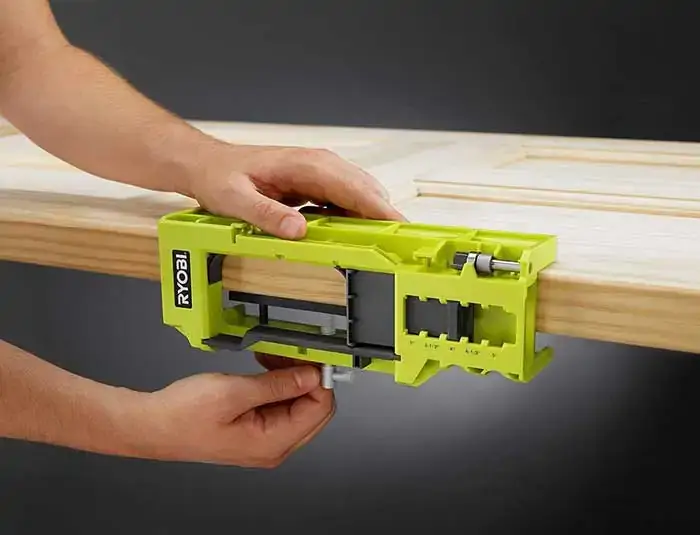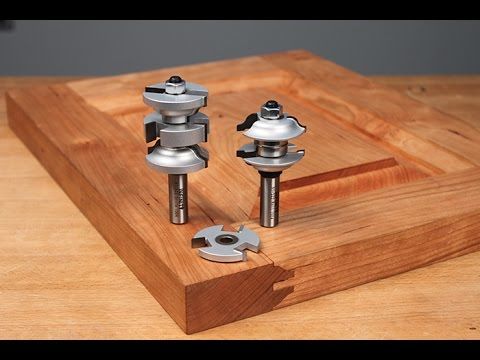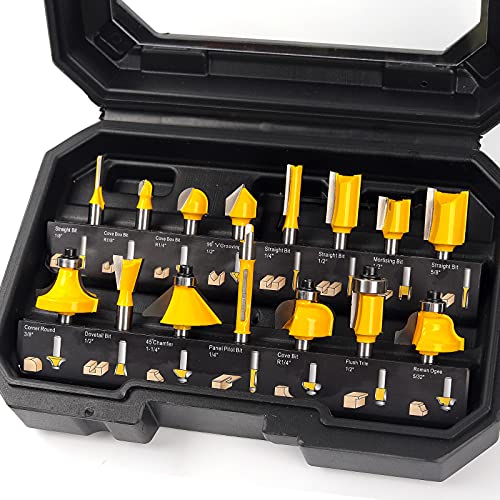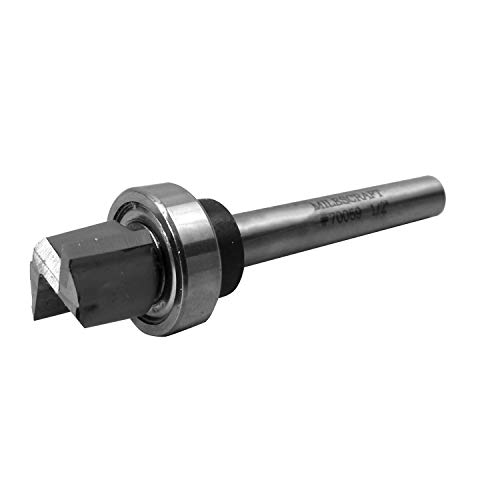Often, we buy doors prehung in their jambs with the hinges in place. It saves time. Moreover, factory-installed hinges are highly precise and fit better with other factory-sourced fittings.
However, you can also cut your hinges and install the jambs if you wish. It’s a fairly detailed process. However, it’s cost-saving, and the acquired skills can prove invaluable down the line.
Below we discuss how to DIY-cut door hinges and review what router bit to Use for door Hinges.
What Router Bit Should You Use for Door Hinges?
Ideally, you should use 1/2-inch flush trim router bits for door hinges, though you can also use straight bits with good results. It depends on many factors, including the door type and material. Generally, we recommend a 1/2-inch to 3/4-inch diameter and a 1/4-inch cutting depth.
Why are Door Hinges Recessed?
Door hinges are recessed to eliminate gaps between the frame and the door when you close the door.
Eliminating gaps is important for your security, health, hygiene, and the home’s energy efficiency. For example, it makes it more difficult for burglars to break through the door.
Additionally, it keeps out bugs and insects and prevents the loss of conditioned indoor air.

Factors to Consider When Choosing the Correct Router Bit to Mortise Door Hinges
- Bit type: There are many types of bits, from straight bits to flush trim bits, rabbeting bits, and multi-profile bits. We recommend flush trim bits for cutting door hinges. However, straight bits are just as effective.
- Measurements (Diameter and Depth): We recommend 1/2-inch diameter bits, though some people are happy with 3/4-inch and 1/4 models. The best cutting depth is 1/4 inches.
- Door type: Many bits work equally well for small and large doors, regardless of the wood type. However, it helps to find something more suited to the door type.
- Versatility and longevity: Many people want router bits with multiple applications. In that case, straight bits are more versatile than flush trim bits. Meanwhile, longevity depends on the construction material.
- Single bit or a whole kit? Door hinge router bit kits are ideal for beginners who need to test a few options before settling on the best solution. Meanwhile, industry professionals who already know what they need can purchase a single bit; it’s more cost-effective.
What Router Bit to Use for Door Hinges-The Best Door Hinge Router Bit Reviews
Although there are hundreds of router bits, we believe the three below are some of the best options;
1. MNA 1/4-Inch Router Bit Set (15 pieces) + Carrying Case
- Bits Precisely match the requirement of the American dimension and standard.
- American industry classification MNA Carbide.Provide superior wear resistance and sharp edges for the best finish.
- MNA 15-piece set is a common router bit set for the DIYer woodworker. It has a great variety of the most popular carbide-tipped bits in a Classical Wood Case.
This 15-piece router bit set from MNA is the best hinge mortising router bit set if you’re interested in an all-in-one bit kit. Moreover, it’s ideal for both DIYers and professional woodworkers who regularly cut door hinge mortises.
It proves all the router bits you need for MDF, hardwood, softwood, and particle board door hinge installations. Additionally, the carbide-tipped bits are durable and long-lasting.
The routers are provided in universal 1/4-inch shanks compatible with all major handheld and motor-powered routing instrument brands, including MNA, Bosch, Matika, DeWalt, Kowod, and Black & Decker.
It’s a very affordable kit too!
2. Milescraft 1/2-Inch Bearing Guided Straight Router Bit
- Tungsten Carbide Tipped for long lasting durability
- Bearing guided bit eliminates the need for guide bushings
- 1/4 inch shank fits most collets
This product from the Milescraft Store is the best router for door hinges if you want a single device rather than a tool kit. The hard-wearing tungsten carbide-tipped tool is a bearing-guided bit that eliminates the need for guide bushings.
The 1/4-inch shank fits most collects, while the 1/2-inch straight is excellent for mortising and other router projects. This unit replaces Milecraft’s 1/2-inch bearing-guided router bit, which came with door and hinge mortise kits. It costs under $10.
3. Yamakoz 1/4-inch Shank Flush Trim Hinge Mortising Template Router Kit
- Shank Diameter: 1/4", Cutting Diameter: 3/4"; Cutting Length: 7/16", Total Length: 2"
- C3 Micro-grain Tungsten Carbide Cutters, Solid Hardened Steel Bodies with Anti-Kickback Design
- Two flute carbide cutters with 1/4" shank. Perfect for Routing door hinge mortises using a hinge template.
Finally, you can opt for the 1/4-inch shank flush trim hinge mortising router kit from Yamakoz. The C3 micro-grain tungsten carbide tipped bit has a 1/4-inch cutting diameter and a 3/4-inch cutting length.
The rest of the body is made from hardened steel and features a kickback safety design.
This two-flute router bit routs clean cutouts for hinges and other shallow cutout projects. It’s a great choice for MDF, solid wood, and particle board and can be used for wooden door frames, window frames, and boxes.
How to Mortise a Door Hinge with a Router Bit
The following is a step-by-step guide to help you cut clean door hinge mortises with a standard router bit.
Requirements
- Wood chisel
- Utility knife
- Hammer and mallet
- Hinge mortising jig
- Router with a piloted bit
How to Cut a Door Hinger Mortise with a Router Bit: Step-by-Step Guide
- Score around the hinge: Set the hinge on the door spot where you wish to install it. Then, holding it firmly with one hand, trace around the edges with a utility knife.
- Chisel the scored cut line: You need a one-inch or one-and-a-quarter-inch chisel for this step. Hold it vertically with the beveled side facing the mortise and tap gently with a hammer. Ideally, you want to cut the wood 1/8-inch deep. Repeat for the whole hinge outline.
- Set the router depth: The router only cuts depending on your settings. So, find out the thickness of your hinge leaves and set the router to approximately the same depth. Alternatively, loosen the depth setter, place your hinge under the setter, and tighten the screws to mark the depth. Then remove the hinge.
- Make the cut: Position the router on the hinge outline (created in step #1) and plunge it until you’ve cut the required depth. Repeat for all four sides of the outline, then clean up the wood shavings.
What if you don’t want to use a router? Here is a guide on how to round edges of wood without a router.
FAQs
Can you use a router to cut/mortise door hinges?
Yes, you can cut a hinge mortise using a router and hinge mortising jig. It does so with precision and uniformity of depth, resulting in perfectly seated, flush hinges. To begin cutting, clamp the jig to the door and use it to guide the router through the cut.
Read also: Can you paint door hinges?
How do you route door hinges?
Routing door hinges is easy. You need an electric router, tape measure, and a carpenter’s pencil. Use the tape measure and pencil to measure and mark out the hinge outline. Then set the router’s depth using the depth setter, place the electric router on the outline, and begin cutting. These actions require your doors to be made of the best wood for doors.
Which is the best router bit for door cabinet door hinges?
We (and many other experts) recommend 1/2-inch router bits for cutting cabinet doors. It offers the highest stability and guarantees better performance than smaller bit sizes. To be precise, consider a half-inch flush-trim router bit. However, some people find 3/4-inch and 1/4-inch bits more suitable. It depends on the project.
How to mortise/route a door hinge without a router?
There are several ways to cut a door hinge without a router. For instance, you can use a chisel to score the hinge outline. Alternatively, use a power drill. Both methods work excellently. The only difference is that power drills require electricity, while chisels are hand-powered tools.
How do you cut a door hinge with a Dremel?
First off, it’s true that you can use a Dremel to cut out the hinge’s housing. But, more importantly, it’s a straightforward process. First, measure and mark the outline, then adjust the Dremel’s cutting depth and wear your PPEs. After that, align the Dremel router bit with the cut marks and begin cutting.
Can you use a trim router for a hinge mortise?
Yes. A trim router with a plunge base is a good choice for cutting hinge mortises. It obviates the need to tip the router into the wood. Moreover, the guide provides smooth and evenly lined mortise sides. We especially recommend it for inlay pieces.
Final Thoughts
Mortising a door hinge using a router bit is easy if you have the right tool. So, you want to spend some time shopping around. Generally, 1/2-inch flush trim bits work best.
However, straight bits are almost as effective. Make sure to set the cutting depth correctly.




